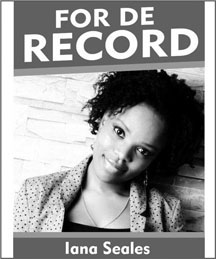The declining standards of our performances in sports was put into sharp focus when the team we prepared for the London 2012 Olympics returned following a poor showing – the reality was apparently so upsetting to the Director of Sport that he severely criticised the group calling their showing “miserable.” The Guyana Olympic Association (GOA) later summed up government support for sports as pretty much the same time thing – miserable.
To paraphrase the GOA, successful performances require more than the infrequent cash donations to travelling contingents, hastily written cheques in support of initiatives (which often come in the wake of media scrutiny and official condemnation), and limited government investment in sports.
 Put differently, there are no clear goals for sports development and the system which is expected to build programmes to find and develop elite athletes is underdeveloped and, at best, archaic. It is no surprise then that the returns we have been seeing simply reflects the investment.
Put differently, there are no clear goals for sports development and the system which is expected to build programmes to find and develop elite athletes is underdeveloped and, at best, archaic. It is no surprise then that the returns we have been seeing simply reflects the investment.
But we have had successes across sporting disciplines, from hockey and table tennis to swimming and squash, and track. To put this in context, some local federations and clubs have developed and implemented plans for athletes’ development and are self-funding their participation at international tournaments. This has led to increased visibility for some of our rising stars on the world stage and opportunities for scholarships to US colleges.
To be more specific though, our encouraging prospects for sporting success are largely due to the sports men and women who push beyond the noted and, at times, seemingly endless obstacles – we occasionally have reason to celebrate because of their determination, their mental toughness, and their coaches and relatives who are putting in the hours and the finances, and giving crucial support. This is the harsh reality and to add to their struggles, we don’t even show our support. To some of us, support for our athletes is as alien a concept as making a small donation to the development of community initiatives but we queue up for hours at the airport waiting to greet foreign entertainers. Who greets our athletes when they return home apart from relatives, friends and the occasional official seeking a photo op?
Our athletes as recently revealed during a public forum organised by the GOA are leaving for international tournaments with cash assistance totalling US$10 a day. Indeed, this sum is negligible when the tournaments are all expenses paid but this is not always the case. For some tournaments, this cash assistance is a meal. What does this do for morale?
Without question we have phenomenal athletes in Guyana but our elite athletes are in very short supply. The elites are the athletes who are ranked within the top 30 of the world based on their respective sport rankings and have made the finals in their event at the international level. And these days, it takes the elite to compete.
We need only look across the region to see how Jamaica has designed and refined a strong home-based sports programme that has produced elite athletes who are dominant in multiple sporting disciplines. The island, following years of consistent investments in sport, has produced track stars the likes of Usain Bolt, Merlene Ottey and Herb McKenley.
The Jamaican model has been tried, tested and implemented across the region. At present, the rising stars in Caribbean sports are either training in Jamaica, competing in Jamaica or learning from the Jamaicans.
The question is what are we doing? What progress have we made since the poor showing at the 2012 Olympics?
These questions are recurring, relevant, and they recently came up at a public forum organised by the GOA. It is unclear how much promotion went into the forum, which focused on the future of sports in Guyana, but as it turns out a discussion as important as this could only draw thirty persons maximum.
In fact, the initial number when the discussion started was twenty, the remainder eventually filed into the YMCA auditorium at Thomas Lands.
Mere minutes into the discussion the vacant seats in the auditorium indicated more than just a poor turnout; they reflected a discouraging national psyche on the declining resources and standards in our sports.
“Sports is dead in the school system… in the country,” a participant remarked and with those few words the reality set in.
Behind the laudable performances of Cassey George and Kadecia Baird at this year’s Carifta Games in Martinique and the recent success of our hockey team, is the harsh reality of our sportsmen and women who struggle against a system that offers limited support and exposure to quality training, unsuitable facilities and for those not so lucky like our cyclists, zero facilities. This is in addition to the infrequent opportunities to compete internationally, among other obstacles.
For more than ten years, a National Sport Policy has been in the pipeline, seemingly being developed to provide a framework to treat our sports in a more holistic manner and build stronger national competitive programmes that will produce elite athletes. There is no indication from government, not in recent months at least, as to when the policy would be completed and implemented though some suggestions have pointed to a June 2014 deadline for completion of a draft.
While this has been ongoing, the national school sports curriculums have weakened across the country due to what sporting officials call a lack of and misuse of funds. Sports, once central to youth development in the country, has been relegated to an optional choice on the curriculum and is increasingly being ignored.
The anecdotal evidence gathered by sporting officials indicate that parents are increasingly linking sports with poor academic performance and as a result, students are giving up sports to take more lessons and write more subjects. Maybe it’s time to reemphasise this point to parents: research has consistently shown that sports impact positively on academic performances.
“Lessons is destroying sports,” an official commented at the forum and the discussion quickly moved to how the culture of taking lessons has pushed youths away from sporting activities they once engaged in.
From lessons and declining interest among youth, officials underlined the major issues affecting sports here. As the officials at the public discussion reasoned, any serious attempt at building a stronger sports programme would require a heavy investment in the schools. At present, government funding for school competitions and related events is inadequate or, as one participant observed, “insignificant.” The programme has been limping along year after year with limited financial backing and constantly plagued with reports of mismanagement.
As one commentator observed, the Jamaicans are finding and training their elite athletes in the schools – an effective system that emphasises competitive evaluation and mental preparation when students are very young. The school programme here is, as officials articulated, crucial to the development of Guyanese athletes but foundations for cultivating an elite sports mentality are disappearing from the schools and no alarm bells are going off.
Have a question or comment? Connect with Iana Seales at about.me/iseales





